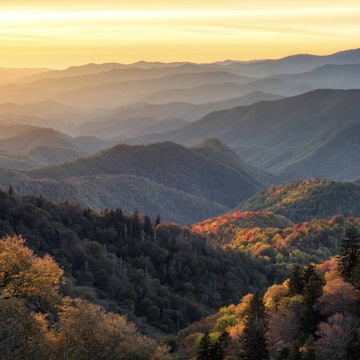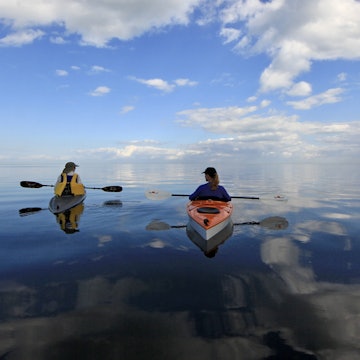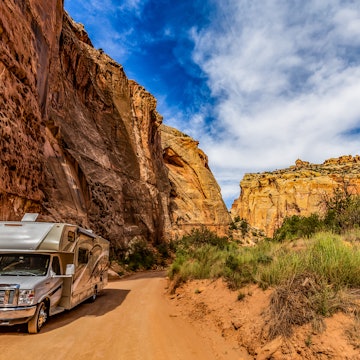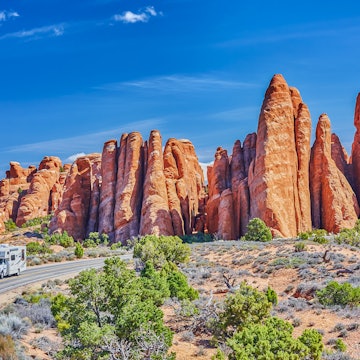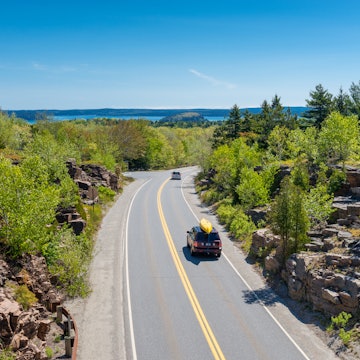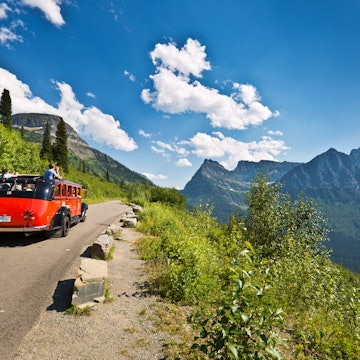
11 of the best experiences in Great Smoky Mountains National Park, USA

Oct 10, 2025 • 7 min read

Fishing in Great Smoky Mountains National Park. dwhob/Getty Images
There is no shortage of nature-driven euphoria in Great Smoky Mountains National Park. Towering hardwoods, quiet streams and even the odd roaming black bear are accompanied by a steady, rolling fog generated by native vegetation – hence the name "Smoky" – which adds to the visual allure. Hugging the East Tennessee–North Carolina border, there are 150 trails, 2200-plus streams and more than 520,000 total acres to explore within this national park. It's no wonder this is the most-visited national park in the US, attracting up to 13 million visitors in recent years.
Part of its popularity is that it's totally free to enter. The hikes to peaks in excess of 6000ft, serene jaunts to waterfalls, and winding scenic drives amid vivid foliage and historical mills certainly don't hurt either. And that's just what's within the park's official confines, let alone the bonus landscapes and family-friendly gateway towns waiting just outside.
Prepare for your very own multifaceted adventure with these top experiences in Great Smoky Mountains National Park.

1. Climb the park's tallest peaks
Amid the Smoky Mountains' landscape, three peaks reign supreme – Clingmans Dome (6643ft), Mt Guyot (6621ft) and Mt LeConte (6593ft). You can summit them all, each with its own picturesque rewards waiting at the top.
Clingmans Dome has a paved but super-steep half-mile finale to its peak, where the brave are treated with vistas for 100 miles on a clear day. Mt Guyot is a strenuous trail lover's dream, with a thick forest-filled homestretch that will give any experienced hiker a sweat. As for Mt LeConte, a hike via Alum Cave Trail is among the park's most popular routes, where stone steps guide you through Arch Rock (yes, an arch!) and blossoming rhododendrons greet you in the springtime.
2. Trek a portion of the Appalachian Trail
From Maine to Georgia, the Appalachian Trail is a nearly 2200-mile bucket list hike for outdoor enthusiasts, and more than 71 miles of it zigzags through Great Smoky Mountains National Park. Starting in the south at Fontana Dam – a kayaking hot spot with a quiet lake – the trail stretches northeast within the park to Davenport Gap. In between, you can hike the likes of Mt Cammerer and Clingmans Dome.
Planning tip: Should you choose to do the full inner-park stretch of the Appalachian Trail, plan for a 6- to 7-day adventure.

3. Hike to a waterfall
The misty splash of a waterfall sure feels nice come spring and summertime in the Smoky Mountains. Particularly in the spring, the mist has a refreshing chill given the melting snow trickling down from nearby peaks. For families, the Laurel Falls hike is a 2.6-mile round-trip and follows a primarily asphalt path. The hike to Ramsey Cascades is a bit longer – 8 miles – but you're greeted with the most towering waterfall in the park, which spans nearly 100ft.
4. Embrace the charm of a roadside "quiet walk"
Dotting many of the park's roads – including the principal Newfound Gap Road thoroughfare – you'll see periodic "Quiet Walk" or "Quiet Walkways" signs with quaint parking lots. There is a certain rural charm to it all – in total, there are 14 quiet walks in the park, each no longer than a half-mile and giving visitors a quick taste of the woods. A non-strenuous favorite is the 0.6-mile round-trip Hickory Flats Quiet Walkway, which has a small creek at its end.
5. Dig into the park's history and local legends
While the four visitor centers within Great Smoky Mountains National Park will give you a good insight into its terrain, wildlife and history, you can dig even deeper at nearby museums. This area is rich in Cherokee Indian, architectural and geological history. Hit the Great Smoky Mountains Heritage Center in Townsend to learn more, including a visit to the 15-building historic cabin compound. For Cherokee history, the Museum of the Cherokee Indian has life-size figures and interactive video experiences that provide an insightful education.
Detour: From Cherokee, Pisgah National Forest (home to the highest peak east of the Mississippi River, Mt Mitchell) is approximately 70 miles northeast.

6. Take a drive amid orange sunsets and foliage
Driving in Great Smoky Mountains National Park has its perks. Not only is it a seamless way for navigating some of the more popular loops – like Cades Cove and the Roaring Fork Motor Nature Trail – but it provides a bird's-eye view of the green spruce and fir-draped mountains come springtime and vivid red-and-orange foliage in September and October. When it's time for a scenic break or at sunset, prioritize the Ben Morton Overlook, with 360-degree views of Newfound Gap.
Planning tip: October can be one of the busiest months of the year in the park. For the best views at the overlooks, plan an early morning trip to avoid the crowds.
7. Canoe, kayak and fish the park's waterways
Great Smoky Mountains National Park has more than 2100 waterways spanning quiet creeks to fast-flowing rivers. For the canoeing crowd, Fontana Lake – in Bryson, North Carolina – is loaded with turns without rocky hindrances. Kayakers should head to the Nantahala Gorge, south of the park in North Carolina, where white water opportunities abound. Fishing is permitted in all park streams from 30 minutes before sunrise all the way through until 30 minutes after sunset daily. To catch a trout, hit Little River Road, which – you guessed it – has the Little River running beside it, with multiple pull-off points for fishing.
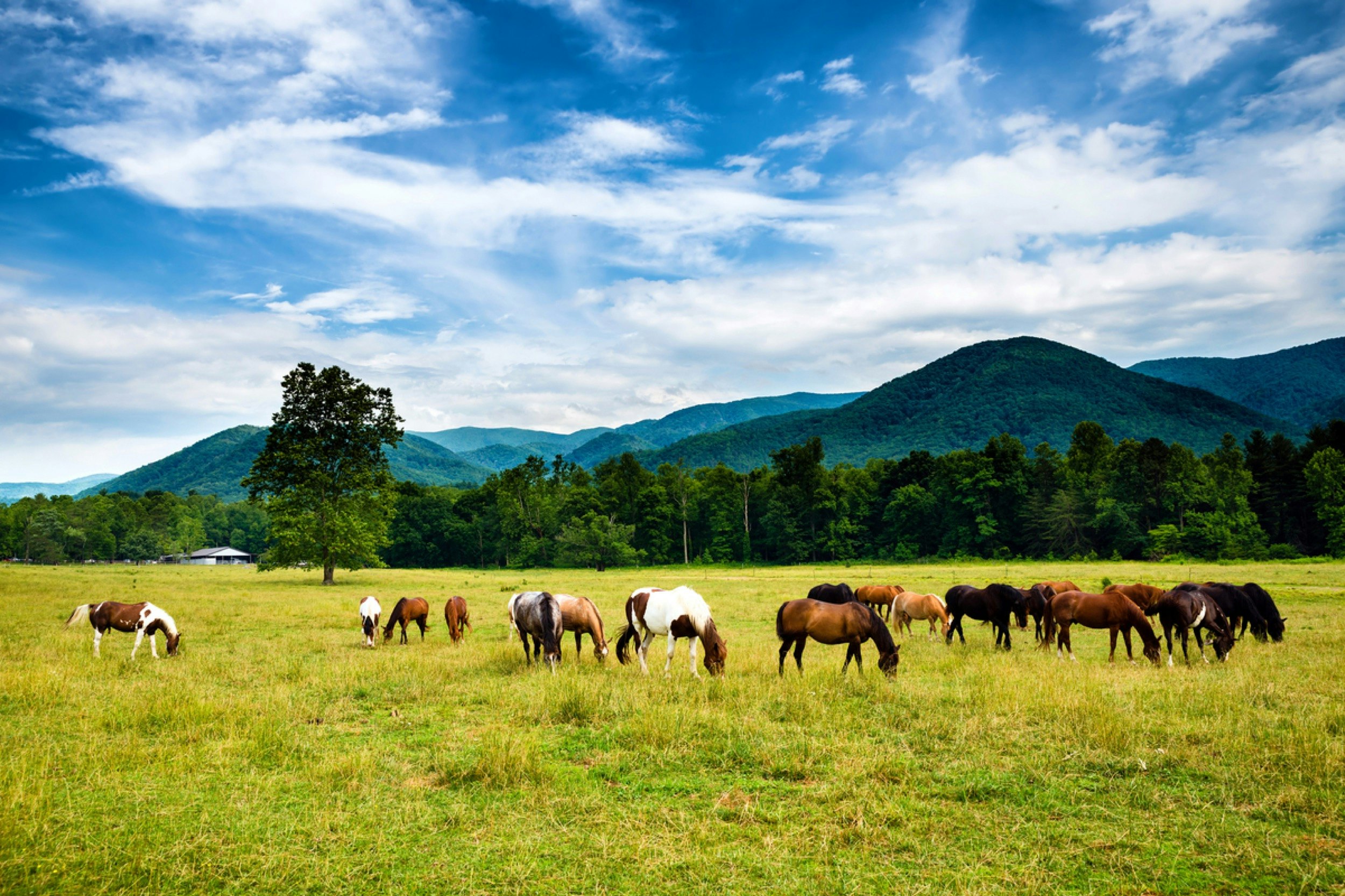
8. Explore a centuries-old European settlement
You'll hear Cades Cove mentioned as a hot spot for a drive – around the Cades Cove Loop – or a hike, for weaving to Abrams Falls. Should you find yourself in this western portion of the park, take some time to explore its historic settlement, too, which has buildings and remnants dating back to the 1820s. This was when the first European settlers arrived at the Cove, and today, you can explore their now historic gristmill, churches and cabins.
9. Book a stay at LeConte Lodge
Want to stay in the park but hate camping? LeConte Lodge is your only option, and you'll have to hike to get there. In terms of altitude, it's the highest guest lodge in the Eastern USA, perched on the upper tier of Mt LeConte.
Planning tip: The grounds consist of three multiroom lodges and seven cabins, making for limited availability. You'll need to book a LeConte Lodge stay months in advance. For last-minute trips, keep an eye on the lodge's website for late cancellations.

10. Explore beyond the park in Gatlinburg and Pigeon Forge
Balance nature with modern pizzazz at one of the numerous Smoky Mountains gateway towns, particularly in East Tennessee. These options include Gatlinburg, which has dueling zip lines at Anakeesta Mountain, moonshine tastings at Sugarlands Distilling Co and Ole Smoky Distiller, and eight Ripley's Believe It or Not spots, including an aquarium with stingrays and sharks.
Pigeon Forge is also a family-friendly destination. The Island complex is home to the 200ft Ferris wheel, the Great Smoky Mountain Wheel, with the Alcatraz East Crime Museum, SkyFly: Soar America and other carnival-esque attractions nearby. Music fans will want to hit Downtown Sevierville, which has a statue honoring country music legend and hometown hero Dolly Parton.
Detour: Knoxville – home to the University of Tennessee, Zoo Knoxville and homegrown barbecue joints aplenty – is less than 30 miles northwest of Downtown Sevierville.
11. Stay in a tiny house, a historic lodge or, oh yes, Dollywood
Camping certainly has its time and place within the park, but so does a more pampered experience nearby. When you fancy some home comforts, your options come in various and often woodsy forms. Tiny house bliss awaits at Little Arrow Outdoor Resort in Townsend, which has a massive pool and hot tub complex, fire pits aplenty and even a pickleball court. A mid-point between Knoxville and Gatlinburg, RT Lodge is one of the top wedding venues in the state, with an Insta-worthy outdoor fireplace set up and patio. Make sure to snag a farm-inspired charcuterie spread from its onsite restaurant helmed by Chef Trevor Stockton.
And then there is Dollywood and all of its twang-infused and roller coaster-filled glory. Make it a seamless commute to the park by staying at the DreamMore Resort down the street, which has nightly s'mores and a wall of records downstairs paying homage to Dolly Parton.
Planning tip: Within the park and in neighboring towns during wintertime, late fall and early spring, be aware of icy roads, particularly at night. There may be park-sponsored roadside signage to help during freezing temps, but stay proactive.








